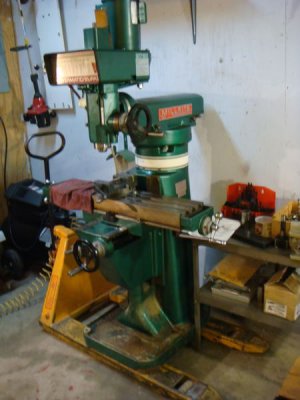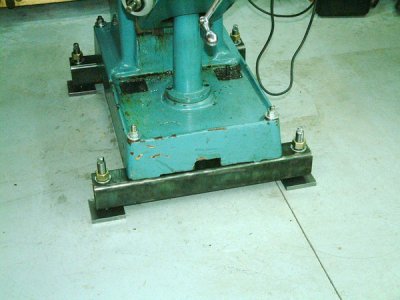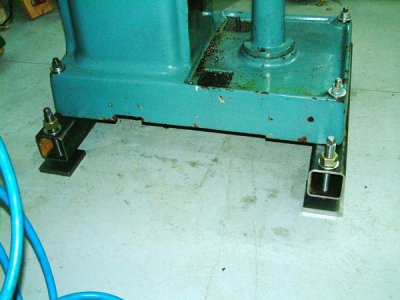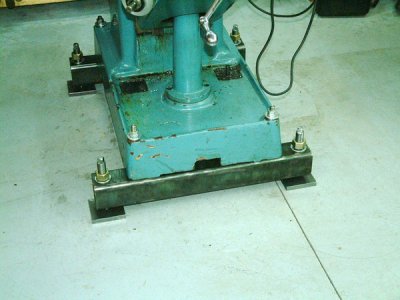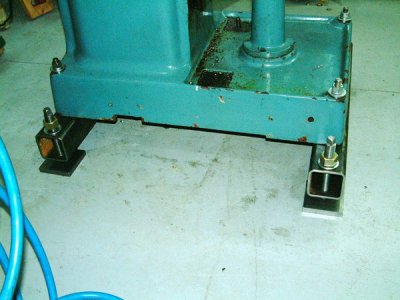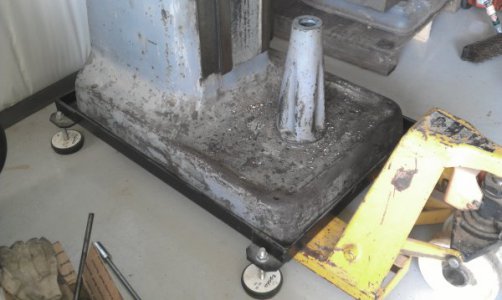Interesting thread - and timely for my next project.
Not to hijack the thread, but I would like to solicit some ideas ......
I plan to take my Induma 1-s turret mill apart (if you've never seen one, the Bridgeport is a clone of the Induma - same general size but somewhat beefier and heavier), clean it, and reassemble it in my basement. Taking the base casting down the bulkhead should be a real joy.
- same general size but somewhat beefier and heavier), clean it, and reassemble it in my basement. Taking the base casting down the bulkhead should be a real joy.
Anyway, I had planned to bolt the base to a pair of 3x3x1/4" pieces of tubing across the narrow width. This would accomplish two things - it would raise the height of the table (I am 6'3") and it would give me enough room to slip a pallet jack under the base to allow for easy placement in the basement (I don't think I could get a forklift down there and while pipe rollers would work, pallet jacks are so much nicer to work with). I had planned to level the beast with shims, but ...
Now I just need to come up with a way to incorporate Randy's idea of tapped holes in the base to allow for leveling - maybe some sleeves welded inside the tubing for the 3/4" leveling bolts to pass through and clips to hold the tubing to the bottom of base. Or maybe I could increase the tubing to 3/8 or 1/2" wall thickness and have the tapped holes in the tubing 1-2" outboard of the side of the base?
Thoughts?
In terms of something to put under the ends of the bolts - I've always used 4x4 or 6x6" pieces of 1/4-1/2" thick steel sheet or plate (whatever I had laying around). Spot mill a 3/4" diameter x 1/6" deep depression to capture the end of the bolt and glue a piece of rubber to the bottom and you're good to goIf you go welding something onto the ends of those bolts, you can guarantee that someday you will need to back those bolts completely out for some reason. I've found that 4x4" "feet" will spread the load enough to support at least a ton per plate and not do damage to a concrete floor. Just a thought.
Brian
Taxachusetts
Not to hijack the thread, but I would like to solicit some ideas ......
I plan to take my Induma 1-s turret mill apart (if you've never seen one, the Bridgeport is a clone of the Induma
Anyway, I had planned to bolt the base to a pair of 3x3x1/4" pieces of tubing across the narrow width. This would accomplish two things - it would raise the height of the table (I am 6'3") and it would give me enough room to slip a pallet jack under the base to allow for easy placement in the basement (I don't think I could get a forklift down there and while pipe rollers would work, pallet jacks are so much nicer to work with). I had planned to level the beast with shims, but ...
Now I just need to come up with a way to incorporate Randy's idea of tapped holes in the base to allow for leveling - maybe some sleeves welded inside the tubing for the 3/4" leveling bolts to pass through and clips to hold the tubing to the bottom of base. Or maybe I could increase the tubing to 3/8 or 1/2" wall thickness and have the tapped holes in the tubing 1-2" outboard of the side of the base?
Thoughts?
In terms of something to put under the ends of the bolts - I've always used 4x4 or 6x6" pieces of 1/4-1/2" thick steel sheet or plate (whatever I had laying around). Spot mill a 3/4" diameter x 1/6" deep depression to capture the end of the bolt and glue a piece of rubber to the bottom and you're good to goIf you go welding something onto the ends of those bolts, you can guarantee that someday you will need to back those bolts completely out for some reason. I've found that 4x4" "feet" will spread the load enough to support at least a ton per plate and not do damage to a concrete floor. Just a thought.
Brian
Taxachusetts


